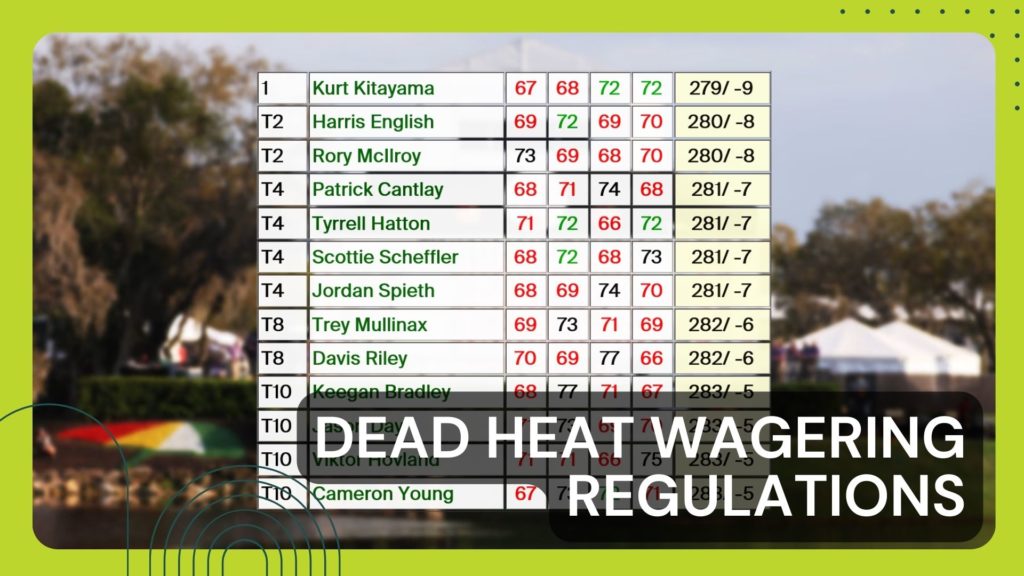
When you place a wager on a golf tournament, two or more players may finish with the same score. This is known as a “tie” or “dead heat”. As a novice golf bettor, it’s essential to understand how ties impact your potential winnings.
In the event of a tie, the sportsbook will typically adjust your payout using either a money split or dead heat reduction formula. With a money split, your original stake is divided by the number of players who tied. For example, if you bet $100 on a golfer at 10/1 odds and he ties with one other player, your stake becomes $50 at the same 10/1 odds.
A dead heat reduction is more complex. It involves calculating new odds based on the number of players who tied and the remaining positions those players can fill. This ultimately reduces your potential payout. But don’t worry; while confusing at first, you’ll get the hang of these calculations quickly.
The key thing to remember is that ties are common in golf betting. So don’t let the dead heat rules deter you. Understanding the basics allows you to make informed wagers even when a dreaded tie occurs.
What Is A Dead Heat?
A dead heat occurs when two or more golfers tie. This often happens when players finish a tournament or a round with the same score. While rare in other sports, ties are relatively common in golf.
When a dead heat takes place, the original betting odds and payouts are adjusted by bookmakers. Usually, they either implement a dead heat reduction or a money split. The dead heat reduction lowers the odds, while the money split divides the original wager by the number of players who tied. These rules ensure a fair resolution for all bettors.
- A dead heat occurs when there is a tie between two or more players in golf
- Bookmakers adjust odds and payouts when a dead heat happens
- A dead heat reduction or money split is usually implemented
- Dead heats are simply part of golf betting that bettors must understand
Although not the ideal outcome, dead heats are simply part of golf betting. As a bettor, you must understand how ties impact your wagers and potential winnings. Learning the dead heat rules will prepare you to calculate new payouts if your player finishes in a tie. With this knowledge, you can enjoy exciting golf bets with complete transparency regarding tied outcomes.
A Glance at Dead Heat Wagering Regulations

When you place a wager on a golf tournament, there is a chance that two or more players may tie for a position. This outcome, known as a “dead heat,” impacts how sportsbooks calculate and pay out winnings. Essentially, dead heat rules reduce the payout to account for the tie.
Understanding these regulations is key to properly judging potential earnings and risks when you put money on golf events. We’ll explore some key aspects of these rules below:
- Sportsbooks typically divide the original stake proportionally when a dead heat occurs. For example, if two players tie, your potential payout would be cut in half. This adjustment accounts for two winners instead of one.
- Aside from dividing the payout, some sportsbooks apply more complex “dead heat reductions” to the original odds. This also lowers potential winnings.
- Ties often occur in bets on top finishes, round leaders after 18 holes, and head-to-head group matchups. Remember that your initial wager may change if your pick is part of a tie.
- While ties can be frustrating, sportsbooks aim to apply dead heat rules fairly. Knowing the possibilities ahead of time can help set expectations properly.
Understanding the basics of dead heat regulations gives you a better grasp of potential risks and rewards when betting on golf. Now, let’s explore some specific examples of how these rules play out.
A Detailed Look at Money Splits
When a tie occurs in golf wagering, most sportsbooks implement a money split to adapt bets. This technique divides your original bet amount evenly amongst the players who tied. For instance, if you wager $100 on a golfer to be victorious and two players tying for first, your original stake would be halved to $50.
The money split assists in simplifying payout calculations if a dead heat occurs. While other solutions like dead heat reductions need math, a simple money split just divides your initial wager. Here’s an example money split scenario shown in a table:
| Original Bet | $100 on Golfer A at +150 odds (2.5 decimal) |
| Potential Original Payout | $350 (($100 * 2.5 odds) + $100 stake) |
| Number of Players Who Tied | 2 (Golfer A and B) |
| New Stake (After Split) | $50 ($100 / 2 players) |
| New Potential Payout | $125 ($50 * 2.5 odds) + $50 (original stake) = $175 |
So, the money split lowered the payout from $350 to $175. While not ideal, it simplifies the settlement for sportsbooks and bettors.
We also recommend that you read Exciting 3 Ball Betting in Golf
Innovative Dead Heat Reduction Breakdown
Here is a straightforward guide to calculating payout adjustments when a dead heat occurs in golf betting. Refer to the table below outlining the step-by-step process:
| Step | Description | Example |
| 1 | Divide the number of golfers who are tied by the remaining positions available. | 3 players tied for 5th place, two spots remained in the top 5. 3 divided by 2 equals 1.5. |
| 2 | Convert your original odds to decimal form. | The original odds were 10/1. In decimal, that is 11. |
| 3 | Divide your original decimal odds by the new decimal odds from Step 1. | 11 divided by 1.5 equals 7.33 |
| 4 | Multiply your original wager by the result from Step 3. | The original bet was $50.$50 x 7.33 equals $366.50. |
Following these 4 straightforward steps outlined in the table, you can easily recalculate your golf betting payout when a dead heat occurs.
